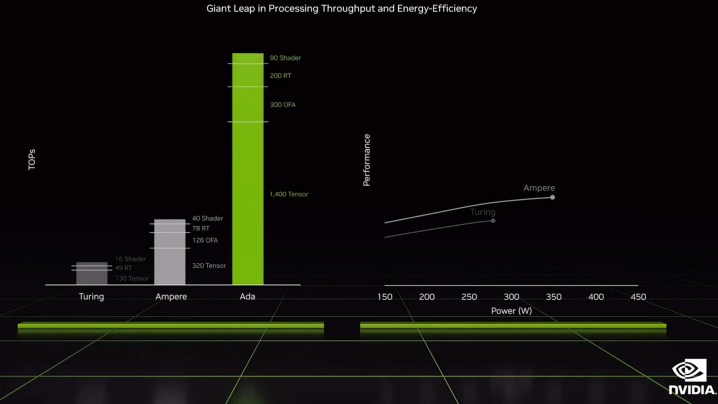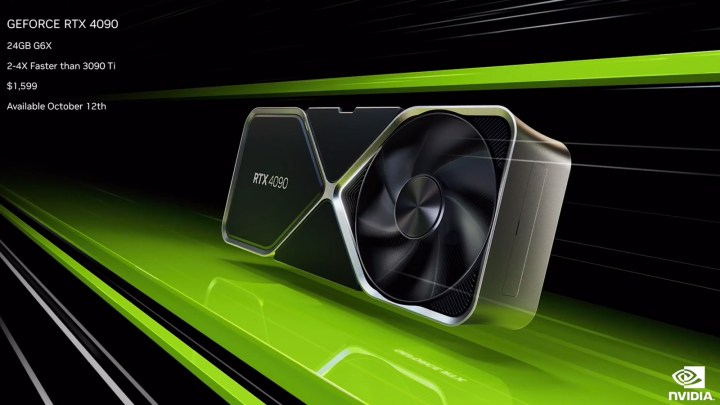The Nvidia RTX 4090 is an upcoming flagship graphics card that looks set to dominate high-end gaming PCs and benchmark top-10 lists in the not-too-distant future. Without much news of AMD’s upcoming next-generation cards, though, the conversation falls to how well the RTX 4090 will fare against the existing kings of the hill: the RTX 3090 and RTX 3090 Ti.
Will these soon-to-be last-generation cards still hold their own, or is the RTX 4090 set to dominate in unprecedented fashion?
Specs

Nvidia released (almost) the full specifications for the RTX 4090 at its GTC keynote speech, debuting it alongside the RTX 4080 for the first time.
| RTX 4090 | RTX 3090 Ti | RTX 3090 | |
| Architecture | Ada Lovelace | Ampere | Ampere |
| GPU | AD102 | GA102 | GA102 |
| Process node | 4nm TSMC | 8nm Samsung | 8nm Samsung |
| CUDA cores | 16,384 | 10,752 | 10,496 |
| RT cores | 144 3rd-gen (rumored) | 84 | 82 |
| Tensor cores | 576 4th-gen (rumored) | 336 | 328 |
| Base clock | 2,235 MHz | 1,560MHz | 1,395Mhz |
| Boost clock | 2,520 MHz | 1,860 MHz | 1,695MHz |
| Memory | 24GB GDDR6X | 24GB GDD6X | 24GB GDDR6X |
| Memory speed | 21 Gbps (rumored) | 21Gbps | 19.5Gbps |
| Memory bus width | 384-bit | 384-bit | 384-bit |
| Bandwidth | 1,1018GBps (rumored) | 1,018GBps | 936GBps |
| TDP | 450W | 450W | 350W |
With the next generation of GPUs, we’ll see a big uptick in CUDA cores again, as well as additional RT and Tensor cores helping to deliver faster ray tracing and better DLSS. Clock speeds have taken a big leap too, which will help deliver the big performance gains Nvidia is claiming are possible, as will the next generation of Nvidia RT and tensor cores. We don’t yet have confirmed numbers on those new cores, but a graph was shown during Nvidia’s GTC showcase that suggested they could come in much greater numbers, too.

The added efficiency of the new architecture on its new 4nm process is what appears to have allowed Nvidia to raise core count and clock speeds so dramatically while maintaining the same power requirements as the RTX 3090 Ti. That’s still a big TDP, but it’s certainly more manageable than some of the rumored totals that were doing the rounds in recent weeks.
Memory configurations seem to remain much the same as the RTX 3090 Ti, though they still represent a big uplift over the RTX 3090.
Pricing and release
The RTX 3090 was released in September 2020, shortly after the flagship RTX 3080. Its price was initially $1,500, but it fluctuated greatly over the past two years, rising to over $3,000 at times. At the time of writing, you can buy it for around $1,100 at most retailers.
The RTX 3090 Ti released in March 2022 with a debut price of $2,000. Shortages at the time meant it could hit $4,000 in some cases, but prices came crashing down shortly after, and today it can be found for as little as $1,200.
The RTX 4090 first debuted at Nvidia’s GTC keynote speech on September 20. It will release on October 12, with a price tag of $1,599. That’s a big drop from the 3090 Ti’s launch price, showing that Nvidia isn’t raising costs dramatically across the board, but it is lifting it from the original RTX 3090’s price, suggesting we may see a modest bump in card prices throughout this new generation of GPUs.
Performance
The Nvidia RTX 4090 is undoubtedly going to be faster than the RTX 3090 and 3090 Ti, but the question is: by how much?
Nvidia didn’t go into great detail with first-party benchmarks at its GTC showcase, instead claiming that the Ada Lovelace GPU at the heart of its new card is capable of up to a two-times uplift in general rasterization performance and up to a four-times increase in ray tracing performance when DLSS is enabled. It only cited a few games in these comparisons, claiming that the two-times increase in performance could be seen in Microsoft Flight Simulator and up to a three-times increase in performance in the newly-announced Portal RTX mod.

Some allegedly leaked benchmarks of the RTX 4090 suggest it will easily break all records, even when paired with a weak CPU. That would make sense, but we’ll reserve judgment on just how good this card is until we’ve had a chance to test it ourselves.
We do have some data on the RTX 3090 and 3090 Ti from our earlier testing, but that mostly showed a minor progression from one card to the other. The RTX 4090 is likely to offer a far more dramatic uplift in performance.

Features
Like the 3090 Ti and 3090 before it, the RTX 4090 will support both ray tracing and DLSS. Also, thanks to its greater RT and Tensor core counts and next-generation hardware, it will see a big performance bump when either or both are enabled, compared to the previous generation. Nvidia talked up its new DLSS 3 algorithm at GTC, showcasing that it can lead to a huge uplift in performance when enabled. That will be game-dependent, however, requiring specific implementation, so like previous DLSS releases, its impact will be limited to start with.
The RTX 4090 will be able to leverage DLSS 1 and DLSS 2 far better than its predecessors, though, so it’s possible that this card will be capable of much higher frame rates in ray tracing and DLSS games, perhaps even enabling 8K gaming in some cases. That’s something that Nvidia teased when it first debuted the RTX 3000 series, but it wasn’t viable outside of a few handpicked games, with DLSS doing most of the heavy lifting. The RTX 4090, however, might have the power and feature set to do it.
The jury’s out — for now
It’s still too early to tell how well these cards will face off against one another in the real world, although so far, all indications point to the RTX 4090 dominating from a performance standpoint but requiring a lot of power in turn. It’s big, expensive, and power-hungry, but it is set to be the new flagship card from Nvidia for some time to come.
Watch this space for in-depth coverage of the card and what it can do once the embargo lifts on our review.
Now all eyes turn to what AMD has planned with its upcoming RDNA 3 generation of GPUs.
Editors’ Recommendations




